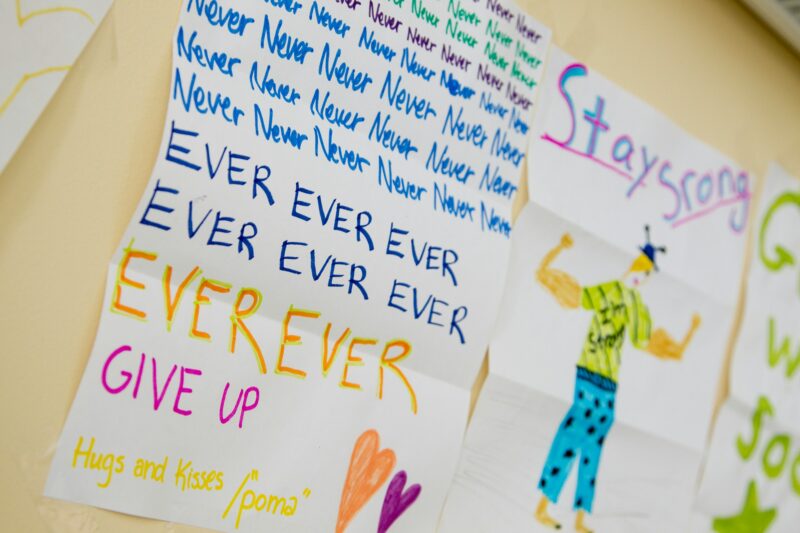by Ada Porat | Mar 29, 2025 | Conscious living, Cope with change, Faith, Life skills, Personal growth, Resilience

Photo credit: NCI, Unsplash
Sometimes during difficult transitions, you have to say, “Enough!” to all the scary voices in your head. You need to remind yourself that those tiresome inner voices do not have your best interest in mind. It’s time to align instead with a Higher strength within you, no matter what.
We all spiral down at times. It can feel like life is punishing you or that you’re completely lost and nothing is worth the struggle any more. You may start giving up on your dreams. Your hopes and heart may turn to stone.
These are not times to fear; they are opportunities to transition into higher truth. You’re being asked to make a choice; to love and advocate for yourself in a more powerful way than ever before. You are challenged to choose faith over fear.
Where fear feels like a monolith of pain, here’s what faith looks like: You breathe deeper. You commit to be kind to yourself. You put one foot in front of the other. Baby steps perhaps, but you keep going. You resist catastrophizing. You refuse to fight yourself or argue for your limitations. And you make this vow: I will not go down. I am not done yet. I will never give up.
Sure, we all have “good” reasons for giving up on our dreams and hopes. We all reach days when just crawling out of bed seems like too much trouble. And yes, we could abandon our faith in ourselves or a Higher Power that guides us.
We may feel as if heaven has forgotten our name and the enemy is hot on our trail. And abandoning ourselves could even be considered realistic in a world that worships success.
But let me ask you this: are you really done yet? Are you completely done living, dreaming, trying and experiencing? Because if you are, you really should be ready to just stop breathing right here, right now.
Here is the other side of the coin: Having faith is not weakness. Faith does not let you off the hook, no matter how much you try. Faith holds you responsible for what you believe because those beliefs determine every action you will take in this life.
You have known all along that there would be detours and disappointment on the journey through life, didn’t you? And it is exactly when the going gets tough, that you need to take strong action, not back off.
When you vow not to abandon yourself in the pain of the moment, you draw a line in the sand. You return to the light that fuels you, and you choose to fight for your real life, your inner core.
When you do that, you’ll remember Leonard Cohen’s song that there’s a crack in everything; that’s how the Light gets in. You’ll remember that all lives are littered with rejection and ridicule and the loss of what we once held dear.
Nobody gets a permission slip to escape harsh realities, although we sure try to find that escape through our addictions and avoidance.
Here’s what to do instead. Take a deep breath and rise again. Choose to trust in the compassionate guidance of a loving Creator instead. Know that your eternal soul will bring new opportunities your way. Never give up on the truth of who you really are. You were born to choose a life that is worthy of you, so choose it!
During times of uncertainty and change, don’t let fear shut you down. Instead, stand tall, hold fast and choose to believe in yourself, your life and the Divine guidance that’s on its way to you right now.
You are more than what you’re facing at this moment: you are the sum total of everything within you, so have faith. Trust that you will find a way and the way will find you; vow to never give up on yourself.
Author Jean-Paul Sarte said, “Freedom is what you do with what’s been done to you.” This is how you choose freedom: it’s the powerful moment when you resist the temptation to believe in powerlessness and victimhood.
No matter how dark your circumstances seem, you can start again to create a new life with heart and integrity; a life that would make your spirit proud. You are not your story; you are the victor who will tell the story in the end to inspire others.
Negativity blocks your potential by convincing you to deny yourself. Don’t go there. Don’t abandon yourself. Let appearances crumble, but do not give up on yourself.
Things will shift. That’s how life works. Tomorrow is another day. The sun will pierce the clouds and there will be other opportunities to thrive.
Feel free to grieve your losses but know that you never need to die to your true identity as a soul. You matter and you are loved by a benevolent universe. You are meant to thrive.
Remember your Source and your purpose, for that is where your support comes from!
©Copyright Ada Porat. This article may be freely distributed in whole or in part, provided there is no charge for it and this notice is attached. For more information, visit https://AdaPorat.com

by Ada Porat | Nov 14, 2024 | Conscious living, Life skills, Mindfulness, Spirituality
Photo credit: Matt Collamer, Unsplash
As humans, we tend to get caught up in the battles in life. It is easy to develop tunnel vision or get blinded by our emotional attachment or resistance to what shows up. We’ve all been there, right! And yet, we can thrive, grow and flourish during times of conflict by understanding the deeper process that’s unfolding.
Every time we become absolutely zealous and charged about something, we actually dissociate from some part of our own being. We inhibit our own progress. Step back from the intense attachment or aversion, and it becomes clear that the person triggering us isn’t very different than us. Like us, they are trying on the 10,000 ways of being human, which includes a very colorful range of expression and thinking – all of them temporary.
Events that may feel overpowering in this moment do not define us either – they are simply temporary props on the stage of life, chapters on our journey of growth and becoming.
Clearly, it is not the people or events of our lives that define us; but our response to them. And when we learn how to respond appropriately, we can use the dissonance of life as a springboard to personal growth.
Whenever we experience anger, fear or disappointment, these uncomfortable emotions offer us a gift: they shine light on parts of ourselves that we’ve denied, pushed into the unconscious, or simply taken for granted. Discord actually helps us grow, because it’s in the to-and-fro of opposing viewpoints that change occurs.
Whenever we experience inner dissonance, it serves us well to remember the words of Master Yoda, “Fear is the path to the dark side. Fear leads to anger. Anger leads to hate. Hate leads to suffering.”
There is another way forward, one that requires us to push beyond the illusionary strength of our fear: it demands the clarity of our hearts.
To progress, we cannot afford anger or impatience to cloud our judgement. We need to see beyond the immediate conflict and feel the deeper connection among all things. In so doing, we will find a better path forward.
Those who differ from us and stand on the other side of the fence are not simply adversaries. They are human beings and evolving souls as well. We are all bound together in the vast, intricate web of the galaxy, our fates intertwined.
The ones who see no path forward except through using brute force are not evil; they are operating at lower levels of understanding. Their rigid attachment to control as the only means of survival blinds them to other viewpoints. They can’t see that conflict borne from fear, anger and hatred is like grasping at sand and only deepens suffering.
Instead of reacting impulsively to dissonance and discord, such times require us to first still ourselves. Patience is needed now.
We know what we need to do. With steady hearts and calm minds, we need to remember that we are all connected. What happens to one, ultimately affects all of us.
The fear-based survival instinct can blind even the best of us, making us do things we’d have once thought unimaginable. It is not so much cruelty but misdirected survival that distorts thinking.
There is no future holding onto fear. We need to let go of fear and find a path forward where we all survive.
The universe hums to a symphony of spiritual laws that echo through the lives of those who listen with open hearts and awakened minds. These unseen forces guide us as we navigate the space between the sacred and the everyday.
The Sufi Poet Rumi expressed it very well:
“When I run after what I think I want, my days are a furnace of distress and anxiety;
If I sit in my own place of patience, what I need flows to me, and without any pain.
From this I understand that what I want also wants me, is looking for me and attracting me.
There is a great secret in this for anyone who can grasp it.”
–Rumi, 100 Bedtime Verses
Like a stone cast into still waters, every action we take sends ripples outward, shaping the destiny of the one who cast it. Mahatma Gandhi lived this truth with every breath, wielding non-violence as both shield and sword because he understood that the tender sapling of peace, once planted, will grow even in the harsh soil of oppression. Tested by imprisonment, hatred, and the weight of an empire’s cruelty, he remained unbowed, trusting that the seeds of love and justice would bloom in time.
At the heart of existence lies love, not brute force. Love is the pulse of creation itself. This is the Divine Love that Rupert Spira calls the everyday name of the Divine. It is the Presence that transcends ego, seeing Divinity in every living thing and calling forth that potential instead of fixating on and hating the shadow.
Saint Francis of Assisi embodied this Divine Presence, moving through the world as a servant to forgotten, broken and mistreated creatures. His love knew no hierarchy. He fed lepers, spoke to wildlife, and loved them all with the same tenderness, even as the world mocked his humility. His faith in Love’s power became his sanctuary, impervious to the storms of derision.
This Divine Presence of love exists in everyone, whether it’s hidden or acknowledged. It connects all of life with filaments of the Creator throughout time and space. When we understand this intrinsic interconnectedness of all life, we must choose compassion and forgiveness, because we know it’s the only doorway to healing for us as individuals and for our shared humanity. This non-violent clarity lets us stand steady and resolute so we can stitch together the torn fabric of a divided nation, knowing that healing can come only when all hands hold the needle.
Faith is here to guide us. It quietly whispers to those who trust in vision beyond sight.
Harriet Tubman lived by this law, her faith guiding her through dark forests and across the waters of the Underground Railroad. Every step she took, every life she saved, was rooted in an unshakable faith in the Divine guidance moving her forward. Fear nipped at her heels but she outran it, carried by her conviction that freedom is not just a dream, but a birthright for all.
And yet, freedom does not come only through holding on, but through letting go. Non-attachment teaches that peace is born not from grasping, but from surrendering. As we let go of old resentments and outdated dreams, we create space for something new to be born – and we can collectively create something better than the flawed constructs of the past.
These spiritual principles are not distant or abstract, they are the living breath of the Universe, calling us to harmony. We can find inspiration and a mirror reflecting our potential by looking at the shining examples of those who’ve gone before.
Together, we can do this! Let conflict and upheaval invite you to surrender to a Higher Power, trusting your heart’s wisdom to follow the path of non-violence, compassion and peace. Open your heart and consciousness to the deeper truths of existence, prompting you toward a more conscious life.
Unlearn the old. Surrender the ancient habits of fear, anger and hatred. It is time for us to grow beyond the ego and reflect our Source. Trust in the unseen hands that guide you, keep your heart open, and look to see the Creator Presence in everyone you meet. This could be a very good time for your soul!
©Copyright Ada Porat. This article may be freely distributed in whole or in part, provided there is no charge for it and this notice is attached. For more information, visit https://AdaPorat.com

by Ada Porat | Oct 15, 2024 | Conscious living, Cope with change, Empowering changes, Life skills, Personal growth, Self-awareness
Photo credit: Frank McKenna, Unsplash
What if, instead of trying to control the process of change, we learned how to make the most of it? Change has been called the only constant in life, and learning how to flow with it can turn the very process of upheaval into a powerful ally.
When we resist the process of change, we also resist the flow of life. Our attempts to control change lock us into identification with the content of the change process instead of its context. It also narrows our focus so we lose touch with the inherent perfection of each moment as it unfolds.
Here are some simple principles to flow with the process of change and make the most of it instead:
Identify With The Contextual Field
We often resist change because we do not want our sense of peace disturbed. A better solution is learning to identify with the contextual field, and not the shifting contents of life. We can choose to focus on the larger picture or context of life, and allow the shifting details of life’s contents to flow past us without attachment or aversion. As each wave of probabilities show up, we are free to select which aspects to focus on and which ones to pass on.
When faced with a job change, for instance, you can focus on attracting an opportunity that would bring you into more alignment with your core values. This aligns you with the context of the Field, not the myriad tiny details. Then, allow this contextual focus to bring you specific opportunities to choose from. By identifying with the contextual Field, you can trust the law of resonance to bring you opportunities aligned with your intentional focus, so you don’t need to control the process.
Really Letting Go
Change can take many forms as we continue to grow into new ways of being, leaving the old behind. We may need to leave behind relationships, jobs, friends, homes or other vestiges of the old that no longer serve us. To really, really let go of the old, there may be aspects of loss and grief that need to be acknowledged.
By acknowledging and expressing our feelings of loss and grief, we can move beyond circumstances and people we have outgrown, so we can move on. It is very important to process these emotions, for it is in expressing them that we find freedom and healing. Emotions that are suppressed never go away – they simply resurface further down to road for us to deal with!
Flying Blind
In shamanic cultures, the bat represents powerful medicine. Bats do not have sight, yet dart about with incredible accuracy and speed because they trust their inner radar. You, too, may feel as if you’re flying blind amid the chaos of sudden change. However, this is an opportunity to trust your inner radar. When deeply connected to your inner guidance, flight through the unknown takes you to higher ground.
Flying blind also challenges our preconceived concepts of life. Fear may prompt us to resist change, yet faith calls us to surrender to the process, trusting the Divine guidance within. As soon as we let go, the current of change can carry us to new perspectives with grace and ease.
Turbulence and Cross Currents
From an energy perspective, any choice or action can be observed as a wave form that ripples outward in all directions. In quantum physics, this phenomenon is known as the Lorenzo Effect. Energies we’d set in motion through previous choices may continue to ripple out and back like waves for a while afterwards. As we make new choices, the old and new wave forms can clash, resulting in turbulence known as standing waves, cross currents and even collapsed waves. We may experience the turbulence as mental fog, confusion or overwhelm.
Don’t let this temporary turbulence throw you off course. It’s part of the process of shifting direction! If you can stay focused during change, the temporary turbulence will give way to a current of greater clarity, ease and understanding.
Remember Why
Overwhelm and confusion only arise when taking our eyes off the goal. When feeling overwhelmed by the process of change, simply bring your focus back to the reasons why you chose change in the first place.
It is normal for change to embody a sense of upheaval. Clashing beliefs, crashing hopes and the looming unknown may bring into question many values you’d blindly accepted before. This is a great opportunity to choose differently. You can respond to change effectively by revisiting core values and bringing your life into more alignment with your soul’s purpose.
Fine-Tune Your Compass
Each one of us creates our own reality, moment by moment. When we set our intention unwaveringly on reaching our highest potential in life, we become unstoppable. Our very being starts emanating the frequency of what we hold in mind, thereby drawing resonant outcomes to us every moment through our continuous intention.
Is change rocking your world right now? This may be an appropriate time to ask yourself whether you are living the life you really want. Are you really doing what your heart desires, or are you compromising for the security of a job, social status or acceptance? Are you deeply fulfilled and joyful, or is dissatisfaction gnawing at your bones?
Remember, your experience is your choice!
To change your experience of life, you need to change your mind about things first. If life doesn’t serve you well, you can change it! It’s as simple as that.
The more consciously you participate in creating your reality, the more you’ll resonate with the outcomes that follow. Even when you do not have control over what shows up in your life, you always have complete power over the response you choose.
Growth – The Ultimate Gift Of Change
Even the subconscious motivators that drive or sabotage our behaviors 90% of the time, can become allies to help us make the most of change. By becoming aware of these triggers, we can clear limiting beliefs from the subconscious, embrace healing for the wounds of trauma, and pave the way for our highest expression of being. This process of fine-tuning and transformation can lead to profound personal growth, which is the ultimate gift of change!
About the Author
©Copyright Ada Porat. For more information, visit https://adaporat.com. This article may be freely distributed in whole or in part, provided there is no charge for it and this notice is attached.

by Ada Porat | Sep 16, 2024 | Conscious living, Cope with change, Decision-making, Healthy boundaries, Life skills, Spirituality
Photo Credit: Clayton Chase, Unsplash
In a world that glorifies action, achievement, and constant self-improvement, we are conditioned from a young age to solve problems and fix what’s broken. We’re taught to hustle, to push forward, and to always be on the lookout for the next thing to improve. We’re praised for quick thinking and problem-solving and rewarded for taking swift action.
There’s undeniable value in this approach. But when applied indiscriminately, it becomes exhausting and unsustainable. The endless drive to “do something” in every situation can drain us, leaving us feeling overwhelmed and inadequate.
There are moments—often the most important ones—when the best course of action is to pause, be still, and allow life to unfold without our interference.
In our personal lives, the urge to act often shows up in subtle ways—constantly trying to improve relationships and situations or relentlessly pursuing goals. While these efforts are noble, the constant push can lead to burnout, anxiety, and feeling that we’re never quite enough.
There is a fine balance between action and stillness. The real skill lies in knowing when to act and when to be still. We often gain the most profound insights during stillness, even as life moves forward without our intervention. It’s in these pauses that clarity can emerge, giving us a deeper understanding of what really matters.
The Wisdom of Stillness
Across spiritual traditions—whether Christianity, Judaism, Islam, Buddhism, Hinduism or Taoism—there is a shared recognition of the power of being present and allowing things to unfold naturally. This doesn’t mean disengaging from life or becoming passive. Instead, it’s about discerning when a situation calls for action and when it’s better to remain still and trust the unfolding process.
Being still, then, is not inaction; it’s a conscious choice, a form of active surrender. It’s the willingness to stop forcing solutions and allow the wisdom of life’s natural rhythms to take over. Appropriately choosing stillness offers many benefits.
Stepping back can bring clarity and perspective. When we take a step back from chaos, we create space for reflection. In this stillness, we can see things from a broader perspective, often revealing solutions and insights that would have remained hidden in the heat of the moment. It’s the pause before the action that allows us to make better choices.
Not every problem requires immediate intervention. In fact, some issues resolve themselves if given enough time. Relationships, for example, can often heal better during periods of quiet rather than immediate confrontation. By giving ourselves—and others—the space to process emotions, conflicts can dissolve naturally, without our constant effort to fix things.
Constantly trying to fix everything is exhausting, too! When we learn to discern when to act and when to remain still, we conserve our energy for what truly matters. We become more focused and intentional, directing our efforts toward what will have the greatest impact.
Practical Ways to Embrace Stillness
In a world that urges frenetic activity, how do we make room for stillness? It begins with recognizing that sometimes the best action is no action at all. Here are some simple practices to help you embrace stillness:
- Cultivate A Spiritual Practice
When we cultivate a relationship with Source, we also develop and fine-tune our inner radar system over time. This allows us to discern how best to respond to any given situation.
- Practice Mindfulness
Even just a few minutes of mindfulness meditation each day can help cultivate inner calm, allowing you to observe your thoughts without immediately reacting to them. This practice builds resilience and presence, helping you stay grounded in moments of uncertainty.
- Set Boundaries
Not every issue requires your attention, and not every problem is yours to solve. Setting clear boundaries around your time and energy allows you to prioritize what truly matters, including your own well-being. Give yourself permission to let go of the urge to control or fix everything.
- Accept What Is
Acceptance is not resignation; it’s a conscious decision to acknowledge things as they are, without the constant urge to resist or change them. In acceptance, we find peace. By allowing situations and people to simply be as they are, we open the door to natural resolution and growth.
- Reflect and Journal
Taking time to reflect on your life through journaling can reinforce the experience of inner peace and stillness. Writing allows you to process emotions, track your growth, and observe how many situations resolve themselves without your intervention. It’s a powerful reminder that not everything requires immediate action.
Moving Forward with Discernment
Learning the art of stillness is an act of self-care and wisdom in a world obsessed with constant activity. It can be very freeing to notice that not every problem needs our attention and that sometimes, the best action we can take is to pause and let things be.
Choosing stillness doesn’t mean abandoning action altogether. The key is balance. Some situations call for decisive action, while others require patience and stillness. The skill lies in discerning between the two and trusting that in stillness, life often resolves itself in ways we could never have planned.
By embracing stillness, we find a deeper sense of peace, clarity, and freedom. We learn that we don’t need to be everything to everyone, all the time. And in that space of letting go, we discover the profound beauty of simply being.
©Copyright Ada Porat. This article may be freely distributed in whole or in part, provided there is no charge for it and this notice is attached. For more information, visit https://AdaPorat.com

by Ada Porat | Jul 24, 2024 | Empowering changes, Gratitude, Healthy boundaries, Life skills, Personal growth, Resilience
Photo credit: Waldoon, Adobe Stock
Living your best life is all about making the most with what you have right now. Clearing the cobwebs from old, limiting thinking can be a great way for you to shine. Here are ten truths to challenge limiting beliefs and empower you so you can make the most of your life now:
1.Nobody knows why anybody does anything – and it doesn’t matter.
You don’t have to figure out why your neighbor ignores you or what happened to someone as a child to make her so mean. We humans are products of both our nature and our nurture – most of the time, we do things simply because we can. Trying to figure out why keeps us stuck in the past, so stop the over-analysis. Let it go, be here now and don’t take things personally!
2. Nobody owes you a thing.
Life is a precious gift, not an entitlement. You could never repay the time, love and support it took to get where you are today: loved ones, teachers and peers believed in you, challenged you and pushed you to become who you are. So, the real question is not what you can get from life, but what you are giving back in return.
3. You’ll be balanced when you’re dead…
Not a moment sooner! We chase balance like the Holy Grail, but it is the very cyclical nature of change that adds momentum to life. If you’re passionate about something, you may well want more of it in your life, so go for it. Your kids won’t turn into losers if you miss a few softball practices, so ease up on yourself. Learn to surf the waves of change with inner equilibrium instead.
4. Multi-tasking is an oxymoron.
Don’t be intimidated by people who do five things at once. Studies show that we don’t actually do more than one thing at a time – we simply switch our attention rapidly between projects, and we compromise on the quality of our output. Would you feel comfortable with a surgeon who juggles performing your surgery while texting and making phone calls? Choose to be masterfully present with one thing at a time instead of trying to be a jack of all trades, and you will ultimately be more effective.
5. You don’t deserve anything you have.
If in doubt, go back to #2. Entitlement is really unattractive. No matter how hard you’ve worked or planned, it is delusional to think that you are in complete control of the outcomes. God, circumstance, the actions of others, and timing all play big parts in your success, so skip the entitlement and practice gratitude for what life brings.
6. You’re ordinary.
Relax, it’s a compliment! Ordinary people are reliable, industrious and consistent. Superstars often lose their inner freedom to the demands of fame, especially when their egos take over. Who would you rather call at 2 AM when your car breaks down – Tony Robbins or your brother-in-law?
7. You’re not a victim; you’re a volunteer.
The old saying that nobody can take advantage of you without your permission is true. We teach people how to treat us. If you don’t want something to happen anymore, don’t set it up in the first place. You change your life by changing yourself first.
8. You’re right. Life isn’t fair.
Life is more random that we could have ever imagined! It is also interesting and instructive when you keep an open mind, for it is from the seemingly random dynamics of change, that miracles emerge and possibilities show up.
9. There is no perfect time.
There is no place where time stands still and standards are lowered to keep you in your comfort zone. At any point in time there are only three things present: you, and life, and this very moment. What you make of this present moment, is up to you. What are you doing with your life right now?
10. Gratitude is next to Godliness.
Cleanliness is way down the list! I have yet to encounter someone at the end of life regretting the dust on their furniture or the stains on their windows… but many regret the opportunities for gratitude they passed up. Eckhart Tolle puts it this way: “Acknowledging the good that you already have in your life is the foundation for all abundance.” Look for things you can be grateful for and you will be amazed at how many more blessings show up.
About The Author:
©Copyright Ada Porat. For more information, visit https://adaporat.com. This article may be freely distributed in whole or in part, provided there is no charge for it and this notice is attached.
by Ada Porat | Aug 9, 2023 | Change bad habits, Life skills, Personal growth, Self-awareness

Photo credit: Frida Lannerstrom, Unsplash
We all have one – that inner critic that spews forth endless criticism, judgment or disapproval about our efforts. It might lead with critical questions like “what were you thinking?” or self-blame like “what’s wrong with you?” or “you’re such a loser!” And since our thoughts hugely influence how we feel and behave, the inner critic’s negative self-talk can become downright destructive.
This critical inner voice was formed out of painful early life experiences where we saw or experienced hurtful attitudes toward us or others close to us. Over time, we unconsciously adopted and internalized this pattern of destructive self-criticism, allowing it to continue the internal monologue even when there is no need for it.
When we fail to separate from the inner critic, it can run rampant in our lives, creating conflict and sabotaging our success.
Buddhist teacher Pema Chodron has said, “If we want to make peace with ourselves and with the world at large, we have to look closely at the source of all of our wars.”
Both war and peace start within us. If we want peace in our lives and in the world, we need to learn how to stop this internal violence and abuse. We must learn how to proactively address our negative thoughts and develop a more productive dialog within.
Here are six steps to tame the inner critic:
1. Develop awareness of your thoughts. Awareness precedes change, and taming the inner critic is no exception. Become aware of the voice of your inner critic; recognize that it is merely an aspect of your psyche and not all that you are. We get so used to hearing our own narrations we can become oblivious as to their source. Pay attention to your inner narrative; recognize that just because the inner critic says something, doesn’t mean it’s true.
2. Allow yourself to observe the inner critic. Become aware of when your inner critic shows up, and what its negative messages are. Notice how its messages are often exaggerated, biased, and disproportionate. Its power to control you lies in its ability to operate unchallenged. Typically, the inner critic’s judgments and accusations may not be fully truth-based. Allow yourself to see this inner bully for what it is, so you can take appropriate action.
3. Examine the evidence. If you are thinking in terms of absolutes (“You’re never going to make it” or “nobody loves you”) ask yourself if that statement is true. Looking at evidence on both sides of the argument can help you look at the situation more rationally and less emotionally. The evidence of insight empowers, while the condemnation of the inner critic always tries to diminish.
4. Identify the truth. Ask yourself what advice you’d give to a friend struggling with self-criticism, failure or doubt. Now, give that same advice to yourself with kindness. If you’ve made a mistake, having a decent regret and resolving to learn from it, is usually enough – you don’t need to condemn yourself for life.
5. Replace overly critical thoughts with more accurate statements. When you find yourself thinking, “I never do anything right,” replace it with a balanced statement like, “Sometimes I do things really well and sometimes I don’t.” You are allowed to make mistakes! Each time you find yourself thinking an exaggerated negative thought, respond with a more accurate statement and move on; don’t ruminate on your mistakes.
6. Balance acceptance with self-improvement. There’s a difference between always telling yourself that you’re not good enough and reminding yourself that you can work at improving. When we resist our flaws, they persist. Instead, accept your flaws for what they are today, and commit to work on improving in these areas. Acknowledging your weaknesses for what they are today doesn’t mean you are doomed to stay that way. It simply reflects your baseline today, and you can use that information to strive toward becoming better. That way, you use the input from your inner critic to motivate you instead of to bully you.
Your inner dialogue with yourself is a critical part of your psyche. It will either fuel your success or prevent you from reaching your full potential. Taming your inner critic and silencing the excess negativity will empower you to live more effectively and to develop your full potential.
About the author
©Copyright Ada Porat. For more information, visit https://adaporat.com. This article may be freely distributed in whole or in part, provided there is no charge for it and this notice is attached.






